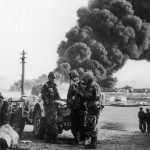The Arabs call this war the “June Setback,” or the “Six Day War.”
During the war, military clashes occurred between Israel on the one hand, and Egypt, Syria, Jordan and Iraq on the other hand, with technical assistance from Lebanon, Algeria, Saudi Arabia and Kuwait.
The Palestinian issue represented an essential element in the Arab-Israeli conflict, which was embodied in this war, as the Palestinian territories that were not occupied by Israel in 1948 were subject to two Arab administrations at that time, the first Egyptian responsible for the Gaza Strip, and the second Jordanian responsible for the West Bank, including East Jerusalem.
At this time, the Palestine Liberation Organization, founded in 1964, was operating from refugee camps in diaspora countries, especially in Syria, Lebanon and Jordan, and leading commando operations against Israel.
According to previous writings by Palestinian thinker Azmi Bishara, Israel has occupied three times its area since the beginning of this war, and within 6 days.
The area of land occupied by Israel in historic Palestine in 1948 amounted to about 77 percent, or about 20 thousand square kilometers, of its total area of 27 thousand kilometers.
**Causes of war
Historical and political sources say that the Israeli military levels had a decisive role in making the 1967 war decision, while marginalizing the role of the then Prime Minister, Levi Eshkol.
She adds that this war, which was adopted by the Israeli military establishment, came within the framework of Israeli expansionist plans in the region, which it planned before 1967, and studied its implementation by launching military operations in Arab countries.
On the other hand, the Israeli narrative claimed that the army initiated the battle for defensive purposes, after assessing the presence of offensive Arab intentions that would pose an existential threat to it.
The military establishment pressured to launch this war, justifying it for several reasons:
- The decision of former Egyptian President Gamal Abdel Nasser, in May 1967, to close the Straits of Tiran to Israeli maritime navigation.
- In May 1967, the Egyptian leadership requested the withdrawal of United Nations forces from Sinai and the mobilization of the Egyptian army in large numbers in the region.
- Egypt’s armament efforts since the end of the 1956 war, and its support for the Palestine Liberation Organization.
- The return of tension on the Jordanian front in 1966 following the killing of 3 Israeli soldiers in a mine explosion, which prompted Israel to launch a harsh attack on the village of Al-Samoui, in the northern West Bank, causing the death of 50 Jordanians, according to Israeli sources.
- Syrian guerrilla attacks on Israeli colonies.
**The outbreak of war
On the morning of June 5, 1967, Israel launched a direct strike on the air forces of Egypt, Syria, Iraq, and Jordan.
The first strike aimed to exclude the Arab Air Force from the battle, and to ensure Israeli monopoly over Arab airspace to launch attacks against ground forces and military bases.
As a result of this strike, the air forces in those countries were destroyed, and the Israeli army moved to the second stage of its plan, which was to bomb Egyptian, Syrian, and Jordanian artillery sites.
The destruction of artillery sites came to repel any Arab military advance, on any of the Arab fronts adjacent to it, in addition to Israel’s desire to remove the heavy and strategic weapons possessed by the Arab armies from the battle.
During the war, the Israeli army also destroyed “anti-aircraft gun platforms belonging to the Egyptian, Syrian, and Jordanian armies.”
According to Israeli writers, dozens of military aircraft participated in launching intensive raids on air bases in Arab countries, the first of which was Egypt, as they first targeted “airport runways, then long-range bombers, and jet fighters, and the last things that were targeted were missiles, radars, and technical installations.” .
According to Michael Oren, an Israeli historian, Israel dropped 180-pound bombs on air bases in Arab countries, each of which left a hole 1.6 meters deep and 5 meters wide, and containing explosive fuses that continued to explode, in order to make these bases unusable. once again.
Oren says that Israel dropped about 100 bombs on one base in Egypt.
More than half an hour after the start of the war, according to Oren, the Egyptians lost about 204 military aircraft as a result of successive strikes.
Over the course of the six days, the strikes continued on the Arab countries, during which Israel, according to historical studies, destroyed about 70 to 80 percent of Arab military equipment, while about 2 to 5 percent of its military equipment was damaged.
**Causes of defeat
According to the Department of Diplomacy and Public Policy, affiliated with the PLO, the Arab defeat in the war was due to several reasons, the most prominent of which are:
- Israel used the element of surprise to strike Arab forces, which caused the Arabs to lose their balance and caused heavy losses among the ranks of their armies.
- Israeli military superiority, especially in the air force, helped it control the battlefields on the various fronts.
- The United States of America and European countries support Israel militarily and economically.
Arab writers also add to these reasons the Arab miscalculation of the existence of offensive intentions on the part of Israel, in addition to the absence of plans for an organized and collective withdrawal, to protect the army from collapse.
**war results
Estimates indicate that between 15 to 25 thousand Arabs were killed during the war, and about 45 thousand were injured, while about 650 to 800 Israelis were killed, and two thousand were injured.
During the six days of the war, Israel occupied the West Bank, the Gaza Strip, the Egyptian Sinai Peninsula, and the Syrian Golan Heights.
According to Palestinian statistics, the “setback” resulted in the displacement of about 300,000 Palestinians from the West Bank and Gaza. Most of them were displaced to Jordan.
Historians said that Israel plundered the areas it occupied in 1967, and exploited their water and economic resources, which contributed to supporting its economy.
The areas occupied by Israel during the war also represented, according to historical references, an important strategic gain on the defensive level, as they formed natural barriers to protect their security depth against any Arab or Palestinian attacks.
As for the occupation of East Jerusalem, it constituted an Israeli historical and religious event that helped it extend its control over what it calls “Greater Jerusalem” (which includes West and East Jerusalem), for the first time since the beginning of the Palestinian-Israeli conflict.
The matter did not stop there, as the war launched a project to expand Israeli settlement into the West Bank and Gaza, and established the principle of “force” by controlling the Palestinian territories and plundering their natural resources, according to historical references.
**Current reality:
Israel withdrew from the Sinai Peninsula, under the peace agreement with Egypt reached in 1979.
In 1994, Israel reached a peace treaty with Jordan, according to which an agreement was reached to return to Tel Aviv the “Al-Ghamr” area, which is located in the Wadi Araba desert in the Aqaba Governorate (southern Jordan), with an area of 4,235 dunums (about four square kilometers), which had been occupied. During the 1967 war.
But Tel Aviv still occupies the rest of the Arab lands, which are the West Bank, Gaza, and the Syrian Golan Heights.
In 1991, the Madrid Peace Conference was launched, under the auspices of the American administration, on the basis of the principle of the “two-state solution,” which calls for the establishment of an independent Palestinian state on the Palestinian territories occupied by Israel in 1967, namely the West Bank and Gaza.
In 2002, the Arab countries adopted an initiative launched by Saudi Arabia, known as the Arab Peace Initiative, which proposes the establishment of normal relations between the Arab countries and Israel, if it withdraws from the Arab territories occupied since 1967 and accepts the establishment of an independent Palestinian state with East Jerusalem as its capital, while finding a just solution to the issue. refugees.
However, the peace process faltered and was not completed due to Israel’s disavowal of the principle of the “two-state solution” and its rejection of the Arab Peace Initiative.
Israel refuses to withdraw from the territory of the West Bank (an area of about 5,860 km), where there are currently more than half a million Israeli settlers.
As for the Gaza Strip (about 360 km), Israel has withdrawn from within it, but it is besieging it and controlling its land, sea and air border


